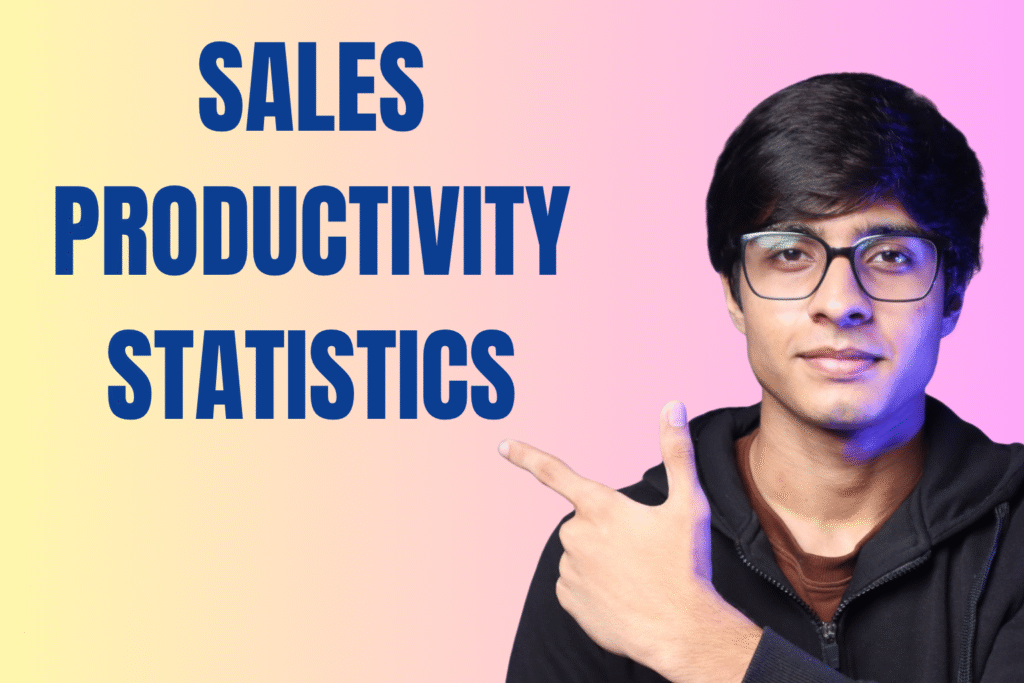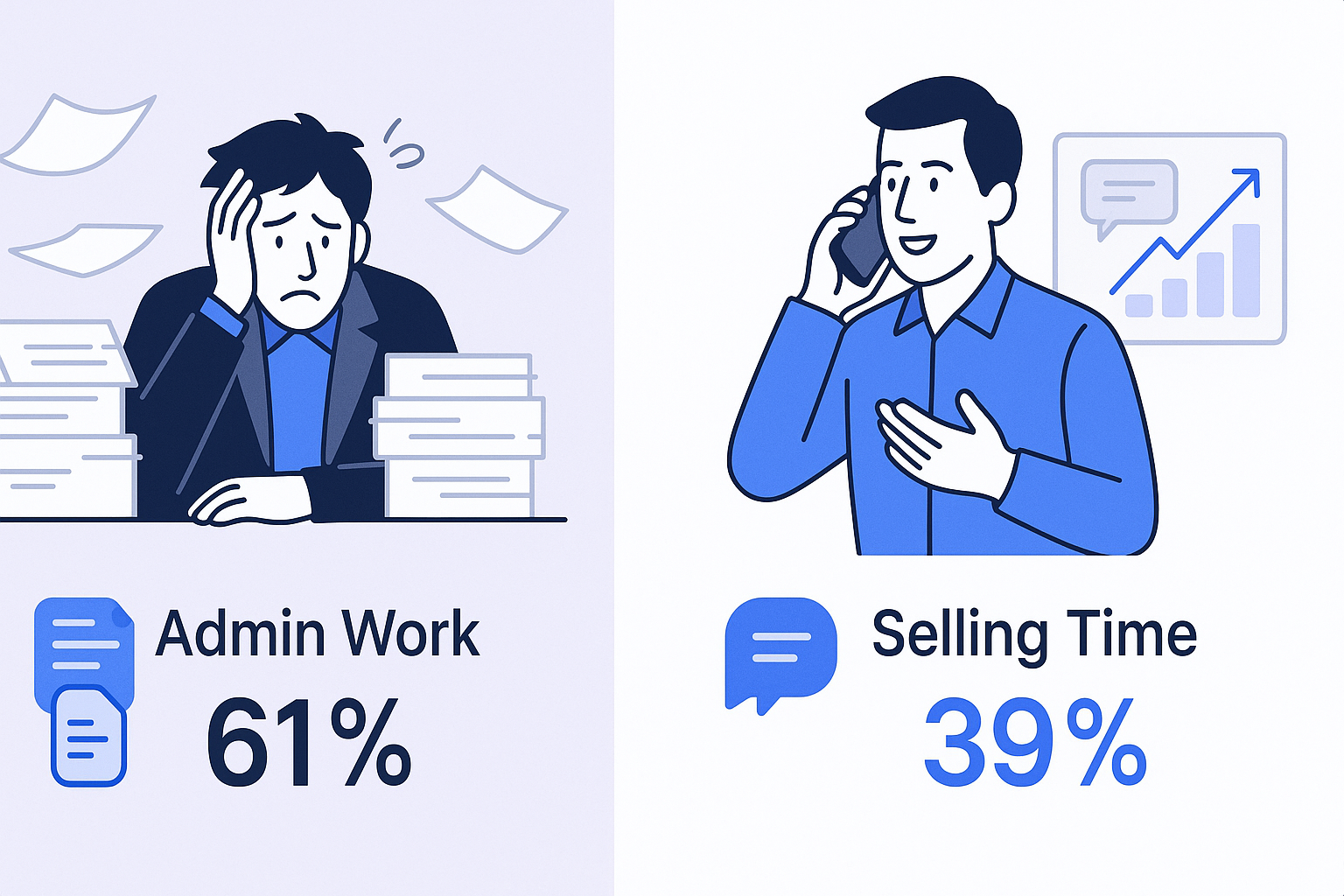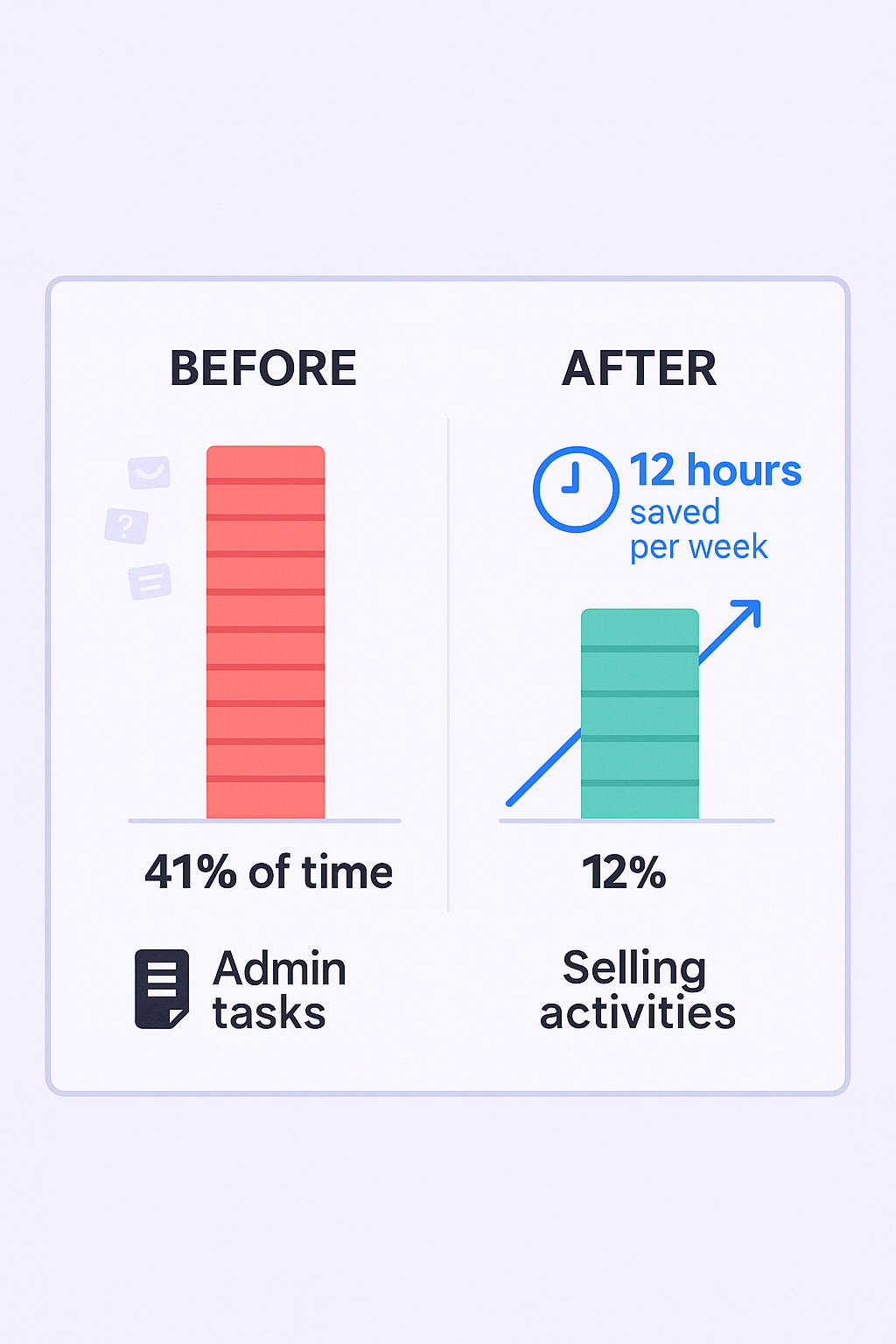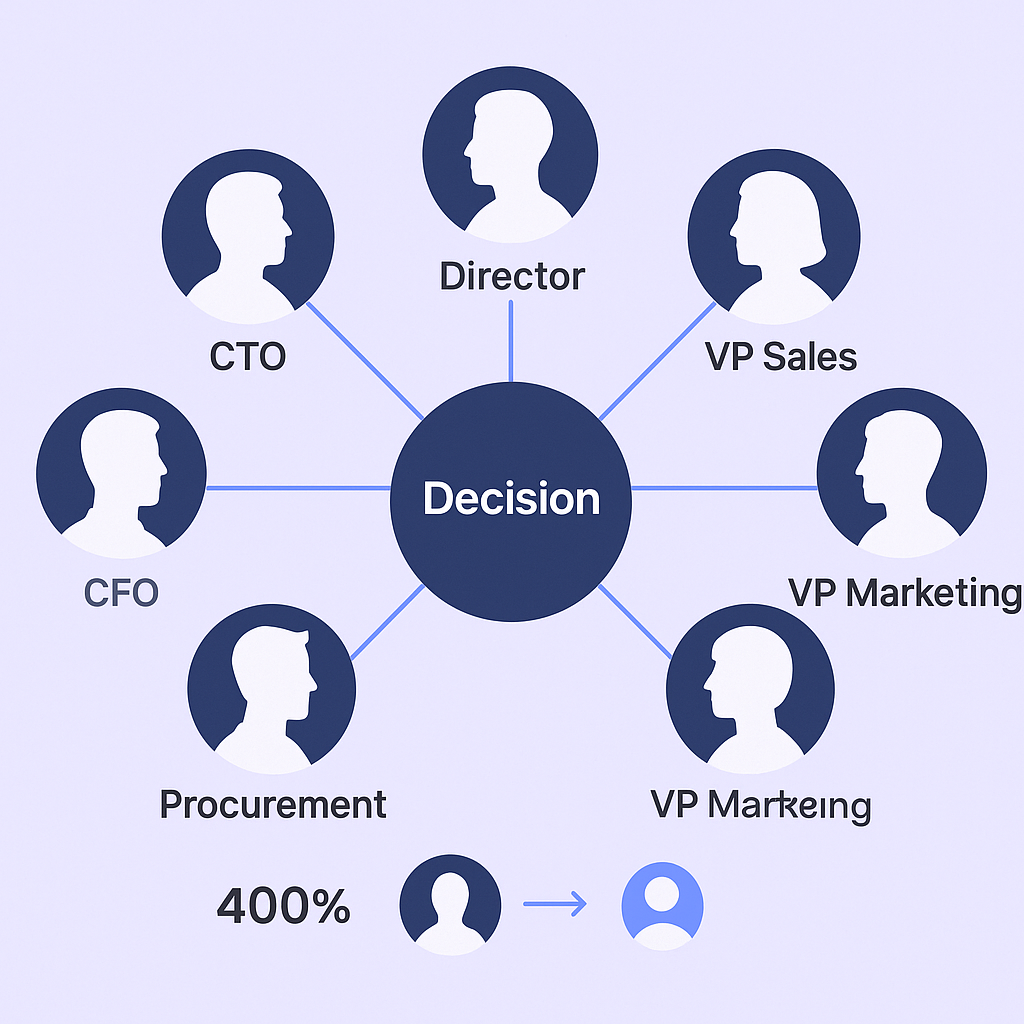- blog
- Statistics
- Sales Productivity Statistics 2025: Data Every Team Needs

Table of Contents
Sales Productivity Statistics
- 59.9% of sales teams are on track to meet or beat their annual revenue targets in 2025
- 84% of individual sales reps didn’t meet their quota last year, showing massive performance disparity
- Sales reps spend only 28-39% of their time on revenue-generating activities, with the rest on admin work
- Administrative tasks alone consume 41% of a rep’s day, killing actual selling time and productivity
- Sellers waste over 27% of their time dealing with inaccurate CRM information and bad data quality
- Companies adopting AI see an average 10-15% increase in sales productivity immediately after implementation
- Sales teams using automation save 12 hours every week per rep, reclaiming nearly three months annually
- Automated teams are 14.5% more productive overall and make 23% more calls per day
- Dynamic, real-time coaching increases revenue by 8.4% year-over-year, a 95% improvement over companies without it
- Sellers with effective managers are 240% more likely to be top performers, especially those with less than five years of experience
- Organizations increased sales training hours by 178% between 2023 and 2024, jumping from 7,534 to 20,965 hours
- Sales training ROI sits at 353%, with training boosting individual rep performance by an average of 20%
- 75% of B2B buyers prefer a completely rep-free sales experience, completing research independently before engaging
- Average B2B purchase involves 7.4 decision-makers, requiring multi-stakeholder engagement strategies for success
- Bad data costs businesses an average of $9.7 million per year in lost opportunities and wasted time
Here’s something wild: nearly 60% of sales teams are crushing their revenue targets this year. Sounds great, right?
But here’s the twist—84% of individual sales reps didn’t hit their quota last year.
That’s the productivity paradox haunting sales in 2025. A handful of top performers are carrying entire teams while the majority struggle with outdated processes, drowning in admin work, and fighting bad data.

The good news? The data shows exactly where the problems are—and what actually fixes them. Let’s dig in.
Top Sales Statistics at a Glance
Statistic | What It Means |
59.9% of teams on track to hit revenue goals | Organizations are succeeding… |
84% of individual reps missed quota | …but most people are struggling |
28-39% of rep time spent actually selling | Time poverty is killing productivity |
12 hours/week saved per rep with automation | AI is giving time back |
67% of lost sales due to poor qualification | We’re chasing the wrong deals |
8.4% revenue increase from dynamic coaching | Manager support is the secret weapon |
$9.7M average annual cost of bad data | Garbage in, garbage out |
Sales Performance Management Statistics: How Are Teams Doing in 2025?
The numbers paint a confusing picture. 59.9% of sales teams report they’re on track to meet or beat their annual revenue targets. Win rates are stable or improving for 91% of companies. Deal sizes are holding steady or growing for 93% of organizations.
So everything’s fine, right? Not even close.
Up to 84% of individual sales reps didn’t meet their quota last year. Another study shows 70% of B2B professionals missed their targets recently. This isn’t a minor gap—it’s a canyon.
What’s happening? The top 15-30% of performers are absolutely crushing it, masking the struggles of everyone else. Your best people are subsidizing your average performers, and that’s not sustainable.
The fix isn’t hiring more people (though 45% of leaders plan to expand teams this year). The fix is making your current teams more effective. And the data shows exactly how.
Dynamic, real-time coaching increases revenue by 8.4% year-over-year—a 95% improvement over companies without it. Sellers with effective managers are 240% more likely to be top performers, especially those with less than five years of experience.
But here’s the problem: 94% of managers claim they coach regularly, yet 53% of sellers say they get coaching quarterly or less. 37% rarely or never receive personalized feedback.
The disconnect? Managers are overwhelmed with admin work and don’t know how to deliver deal-specific coaching. They’re managing activities instead of developing people.
The bottom line: Before you hire your next rep, invest in making your managers better coaches. That’s where the leverage is.
📊 Struggling to Hit Revenue Targets?
LinkedIn outbound fills pipelines with qualified leads while your team focuses on closing deals
B2B Sales Statistics: New Tech Disruptions
Let’s talk about where your sales reps actually spend their time. Spoiler: it’s not selling.
Sales reps spend only 28-39% of their time on revenue-generating activities. The other 61-72% disappears into admin work, data entry, research, and fighting with their CRM.
Breaking it down further, administrative tasks alone consume 41% of a rep’s day. And thanks to crappy data quality, sellers waste over 27% of their time dealing with inaccurate CRM information.
This is the time poverty crisis, and it’s exactly why AI and automation aren’t just nice-to-haves anymore—they’re survival tools.
Companies adopting AI see an average 10-15% increase in sales productivity immediately. Sales teams using automation save 12 hours every week per rep. That’s 2 hours and 15 minutes saved daily, or nearly three months of productive work reclaimed annually.

What does that time buy you? Automated teams are 14.5% more productive overall. They make 23% more calls per day and close deals 20% faster.
The market knows this. The AI sales market is projected to hit $1.3 billion by 2025, and 82% of high-performing sales teams already use ai sales tools.
But here’s the catch: tool sprawl is real. The average rep now juggles at least six different tools to do their job. When those tools don’t talk to each other, you create data silos, tool fatigue, and new inefficiencies.
The solution: Integrated platforms that consolidate your tech stack while maximizing AI-driven automation. Don’t add another point solution—replace three tools with one smarter platform.
🚀 Automate Your Outbound Prospecting Now
Our LinkedIn campaign engine targets decision-makers and books meetings while you sleep
Want to see how automation can transform your outreach? Check out our guide on cold email statistics to understand what’s actually working in 2025.
The Productivity Paradox: Where Time Goes vs. What AI Gives Back
The Problem | The AI Solution | Source Impact |
61-72% of time on non-selling tasks | Automation saves 12 hours/week per rep | Almost 3 months/year recovered |
27% of time wasted on bad CRM data | AI tools increase productivity 10-15% | Real-time data validation |
Too many manual processes | Teams make 23% more calls/day | 20% faster deal velocity |
82% of top teams use ai sales tools | Adoption is mandatory for competitiveness | Revenue protection |
Sales Training Statistics
Organizations are finally waking up to the training gap. Between 2023 and 2024, companies increased sales training hours by 178%—jumping from 7,534 hours to 20,965 hours.
And it’s paying off. The overall ROI of sales training sits at 353%. Training can boost an individual rep’s performance by an average of 20%.
But here’s where it gets interesting: a seller is 63% more likely to be a top performer when they get three things together—an effective manager, regular coaching, and effective training. When sellers use their company’s methodology and receive consistent training, quota attainment jumps to 73%.
So what’s the problem? 62% of sales leaders say their training content is outdated. The biggest gap? Digital selling skills. 48% of leaders cite digital selling as the least addressed area in their training programs.
This is a massive disconnect. The modern B2B buyer completes nearly 70% of their journey digitally before ever talking to a rep. Your training is preparing reps for a world that doesn’t exist anymore.
Organizations with strong sales enablement infrastructure see 49% higher win rates on forecasted deals. They also decrease onboarding time for new hires by 40-50%, getting reps productive faster.
The takeaway: Your training content needs an urgent refresh. Focus on digital engagement, multi-stakeholder selling, and value-based conversations. And make sure your enablement team has the resources to deliver continuous, relevant training that keeps pace with how buyers actually behave.
Sales Funnel Statistics: Changing Expectations
The sales funnel isn’t broken—it’s been completely rewritten by buyers who don’t want to talk to you.
75% of B2B buyers prefer a completely rep-free sales experience. They’re doing their research, reading reviews, and consulting their networks. By the time they engage with your team, they’ve already completed nearly 70% of their buying journey.
And when they do reach out, you’re not talking to one person. The average B2B purchase involves 7.4 decision-makers. That’s seven people with different priorities, concerns, and veto power.

🎯 Fix Your Lead Qualification Problem
LinkedIn’s precision targeting delivers pre-qualified prospects actively seeking solutions like yours
For more on what’s working in modern outreach, dive into our email deliverability statistics guide.
B2B Funnel Conversion Benchmarks: Where Deals Die
Industry | Lead-to-MQL Rate | MQL-to-SQL Rate | What This Means |
Cross-Industry Average | 31% | 13% | Most leads die here |
B2B SaaS | 39% | 38% | Better qualification pays off |
Financial Services | 29% | 38% | Strong mid-funnel processes |
Biotech | 36% | 40% | Best-in-class conversion |
Referrals | 56% | N/A | Quality beats quantity |
Overcoming New Sales Challenges
Even the best processes fail when your foundation is cracked. And in 2025, two structural problems are sabotaging everything else: dirty data and organizational misalignment.
Bad data costs businesses an average of $9.7 million per year. We’re not talking about minor inconveniences—we’re talking about salespeople wasting over 27% of their time because their CRM is full of garbage.
Duplicate records. Wrong contact info. Outdated job titles. Missing fields. It all adds up to miscommunication, lost opportunities, and two reps accidentally working the same account because nobody knows what’s true anymore.
Here’s the scary part: if you layer AI and automation on top of bad data, you just amplify the problem. You’re not fixing anything—you’re poisoning your pipeline faster.
Data governance isn’t an IT problem. It’s a revenue problem. Before you scale any AI initiative, clean your data first. Build validation rules. Create accountability for data entry. Make accuracy a metric that matters.
💎 Clean Data Equals Closed Deals
Our LinkedIn outbound system targets verified decision-makers with zero database decay issues
7-day Free Trial |No Credit Card Needed.
The other challenge is alignment. Despite proven results—49% higher win rates and 40-50% faster onboarding from sales enablement—many organizations still treat enablement like a nice-to-have.
28% of companies cite competing priorities and lack of alignment as their biggest hurdles. Another 19% of stakeholders struggle to understand the value of enablement efforts at all.
Why? Because enablement teams report activity metrics (content downloads, training attendance) instead of business outcomes (pipeline conversion, quota attainment, ARR contribution).
The solution: Enablement needs a seat at the revenue table. Report on metrics that C-suite cares about. Tie every initiative to revenue impact. Make the connection between enablement investment and business results so obvious that nobody can ignore it.
And for better alignment between sales and marketing, remember this: 74% of top-performing companies have strong sales-marketing alignment. If you don’t, start there.
Sales Career Statistics
The productivity crisis isn’t just hurting your numbers—it’s driving your people away.
Sales job transitions increased by 39% recently. In the ultra-competitive tech and software industry, the voluntary departure rate among sales professionals hits a staggering 67%.
Think about that. Two-thirds of your sales team in tech would leave if they got a better offer tomorrow. That’s not just expensive (recruiting, onboarding, ramping new hires)—it’s a strategic disaster. Your best people take relationships, knowledge, and pipeline with them.
Why are they leaving? Top reasons include lack of clear career advancement, insufficient clarity from leadership, and uncompetitive pay. But there’s another factor most companies miss: burnout from administrative overload.
This is where automation becomes a retention strategy, not just an efficiency play.
76% of sales reps report that automation reduces their work stress. When you eliminate tedious, repetitive tasks, reps can focus on relationship building and high-value customer interactions—the parts of the job they actually enjoy.
The results? Sales reps who spend less time on admin tasks report 22% higher job satisfaction. Companies that automate repetitive tasks see a 15% reduction in employee turnover.
The bottom line: Every hour your team spends on data entry, meeting scheduling, or manual prospecting is an hour closer to them updating their LinkedIn profile. Automation isn’t just about productivity—it’s about keeping your best people engaged and happy.
Future-Proof Your Sales Planning
Let’s cut through the noise. Here’s what actually matters for 2025 and beyond.
Organizations with unified sales enablement solutions are 80% more likely to increase their win rates. Not 8%. Not 18%. 80%. Integration matters more than you think.
83% of high-performing sales teams prioritize technology investment, and companies leveraging ai sales tools see an average revenue uplift of 25-30%. The gap between AI adopters and holdouts is widening every quarter.
But technology is only half the equation. As AI handles routine tasks—prospecting, data entry, scheduling, risk flagging—the human role becomes hyper-specialized in complex, high-value engagement.
This means your training needs to evolve. 41% of managers say their reps struggle with engaging executive buyers. That’s the skill that matters now. Along with value-based selling, multi-stakeholder navigation, and consultative problem-solving.
Here’s the proof: top sellers are 60% more likely to present compelling value cases than average performers. That’s not a small edge—that’s the difference between winning and losing complex deals.
So what’s your action plan? Here’s what the data says:
Start with your foundation. Audit your data quality before scaling AI. Bad data makes everything worse, not better. Get your CRM clean, build validation rules, and create accountability.
Invest in manager effectiveness. Coaching drives 8.4% revenue increases. Sellers with great managers are 240% more likely to succeed. Manager enablement isn’t optional anymore.
Adopt integrated AI tools. Don’t add another point solution to your stack of six tools. Replace three tools with one smarter platform that actually talks to your other systems.
Fix qualification before volume. 67% of lost sales stem from poor qualification. Properly qualified leads convert at 40% vs 11% for unqualified prospects. Quality over quantity wins every time.
Track the right metrics. While ARR is your North Star, optimize leading indicators: meeting conversion rates, outbound reply rates, and forecast accuracy (aim for 90%+). Real-time visibility drives real-time improvement.
Improving sales enablement and training is cited as the number one growth tactic for sales leaders in 2025. The organizations winning in this environment aren’t the ones with the biggest teams—they’re the ones who made their teams smarter, faster, and more effective.
Ready to level up your outreach game? Our guide to B2B email marketing statistics breaks down exactly what’s converting in 2025.
Conclusion
The sales productivity paradox won’t fix itself. You can’t hire your way out of it, and you can’t just work harder.
The winners in 2025 understand something fundamental: productivity isn’t about doing more—it’s about removing what’s broken. Clean data. Better coaching. Smarter tools. Ruthless qualification.
Your move is simple. Pick one thing from this article and change it this week. Audit your data. Schedule coaching sessions for your managers. Automate one repetitive task. Tighten your qualification criteria.
The gap between top performers and everyone else is widening. The question isn’t whether to act—it’s whether you’ll act before your best people find a team that already did.
Want to transform your cold outreach strategy? Check out our proven cold email templates that actually get responses.

Boost Sales Productivity with LinkedIn Outbound
Our proven targeting and campaign design drives 3x more qualified meetings than cold email
Segmentation That Actually Converts
LinkedIn outbound targets precise demographics with strategic campaign design and scaling methods

